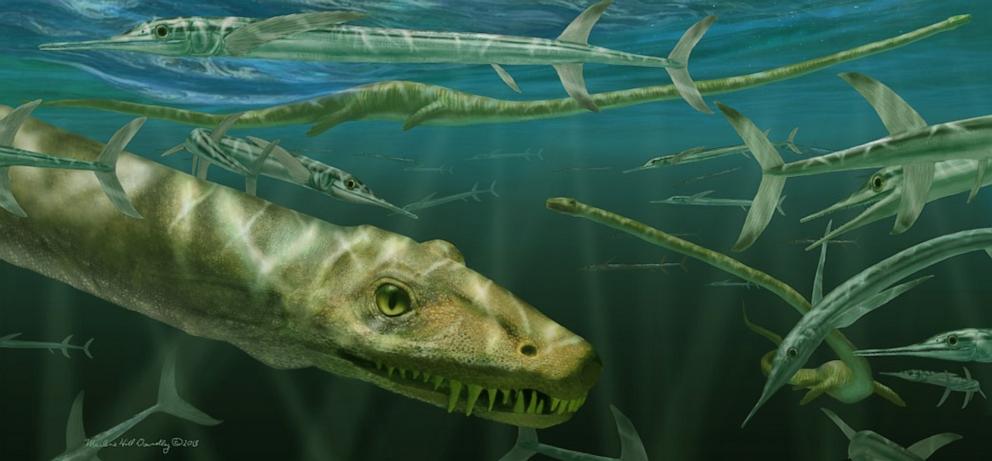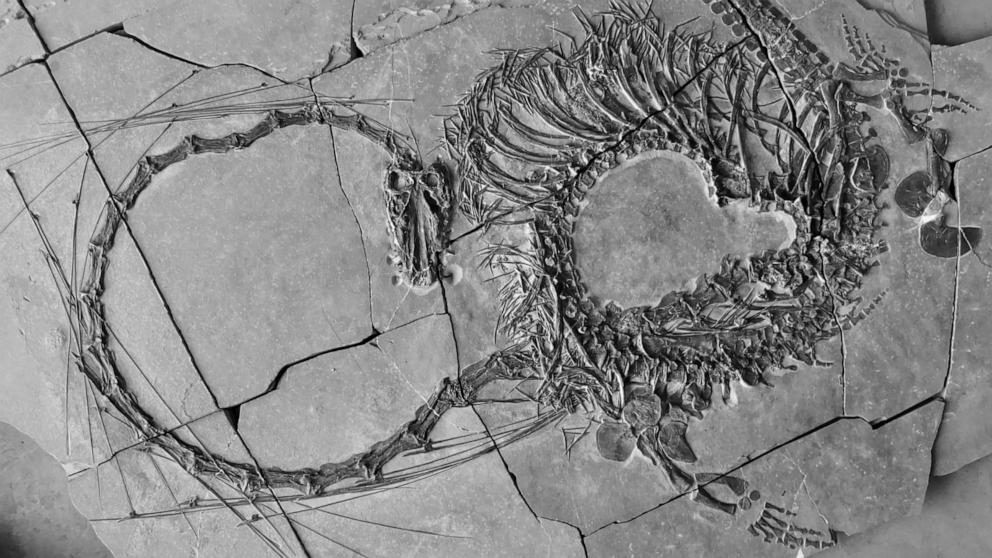Scientists announce discovery of 'very strange' 240 million-year-old 'Chinese dragon' fossil
LONDON -- Scientists in Scotland have revealed a remarkable discovery of a "very strange" 240 million-year-old "Chinese dragon" fossil.
The international team from National Museums Scotland revealed their discovery -- found in Guizhou Province in southern China -- of the Dinocephalosaurus orientalis, a 5-meter-long aquatic reptile from the Triassic period dating back an estimated 240 million years.
"With 32 separate neck vertebrae Dinocephalosaurus orientalis had an extraordinarily long neck that draws comparison with that of Tanystropheus hydroides, another strange marine reptile from the Middle Triassic of both Europe and China," scientists said announcing the discovery.
"Both reptiles were of similar size and have several features of the skull in common, including a fish-trap type of dentition," officials continued. "However, Dinocephalosaurus is unique in possessing many more vertebrae both in the neck and in the torso, giving the animal a much more snake-like appearance."

Scientists say the reptile was "clearly very well adapted to an oceanic lifestyle," as indicated by the flippered limbs and "exquisitely preserved" fishes in its stomach region.
"Despite superficial similarities, Dinocephalosaurus was not closely related to the famous long-necked plesiosaurs that only evolved around 40 million years later and which inspired the myth of the Loch Ness Monster."
The reptile was originally identified in 2003, but this most recent discovery of additional, more complete specimens has allowed scientists to depict the bizarre long-necked creature in full for the very first time.
"It is yet one more example of the weird and wonderful world of the Triassic that continues to baffle palaeontologists, said Dr. Nick Fraser, Keeper of Natural Sciences at National Museums Scotland in the statement announcing the discovery. "We are certain that it will capture imaginations across the globe due to its striking appearance, reminiscent of the long and snake-like, mythical Chinese Dragon."

Researchers from Scotland, Germany, the United States and China studied the fossil over the course of ten years at the Institute of Vertebrate Palaeontology and Palaeoanthropology in Beijing but made their announcement public on Friday.
"This has been an international effort. Working together with colleagues from the United States of America, the United Kingdom and Europe, we used newly discovered specimens housed at the Chinese Academy of Sciences to build on our existing knowledge of this animal," Professor Li Chun from the Institute of Vertebrate Palaeontology and Palaeoanthropology said. "Among all of the extraordinary finds we have made in the Triassic of Guizhou Province, Dinocephalosaurus probably stands out as the most remarkable."
The paper describing the animal has been published in full in the academic journal Earth and Environmental Science: Transactions of the Royal Society of Edinburgh.
"As an early-career researcher, it has been an incredible experience to contribute to these significant findings," said Dr. Stephan Spiekman, a postdoctoral researcher based at the Stuttgart State Museum of Natural History. "We hope that our future research will help us understand more about the evolution of this group of animals, and particularly how the elongate neck functioned."



